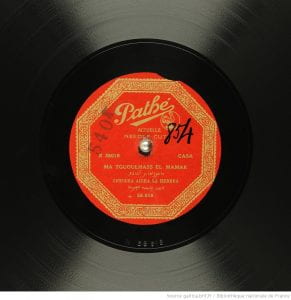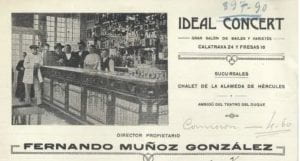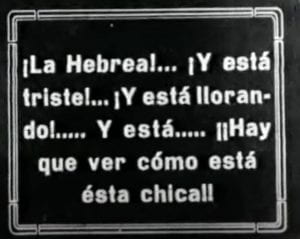Looking for a 14th-century Hebrew bible from Spain on the website of the Bibliothèque Nationale de France, I stumbled on Prof. Chris Silver’s curated collection of inter-war recordings of Andalusi music from Maghrebi singers.

El Mamak 1930
source: Bibliothèque Nationale de France gallica.bnf.fr
One of them caught my attention: Cheikha Aicha ‘La Hebrea’, a Moroccan Jewish singer who in 1930 recorded a cover of Lili Labassi’s El Mamak for Columbia Records. What immediately stands out about this singer, who according to Silver “has barely left an archival trace,” is her nickname: ‘La hebrea.’ At first I thought she might have been from a Moroccan Ladino-speaking family, but in a Jewish setting where everyone is Jewish it’s unlikely that someone would be nicknamed ‘La hebrea’ (‘the Jewess’). That would be more likely if you were the only Jew around, for example, in a Spanish-speaking country whose citizens were prohibited from practicing Judaism, like, Spain.

Ideal Concert hall, Sevilla 1919
source: en.todocoleccion.net
As it turns out, this appears to have been the case, and Aicha ‘La Hebrea’ had a storied career as a singer and bohemian around town in Spain during the 1920s and 30s, where she made a name for herself as a popular singer of flamenco and other Spanish genres. As early as 1921 she is billed as “la artista moruna rutinaria Aicha La Hebrea” (the usual Arab singer Aicha La Hebrea) for a show at Ideal Concert in Seville in 1921 (Eco artístico (Madrid) vol 13, no. 376, Feb 28, 1921).

Circo Cuayás, Las Palmas (1939) source: http://galloscanarias.blogspot.com
She worked in Seville until at least 1925, when she toured Cádiz and the Canary Islands. A Seville newspaper again describes her as a singer of “beautful Arab songs” mixed with a “repertoire of Andalusian couplets”:
Después de haber actuado en Sevilla una corta temporada, marchó a Cádiz, embarcando para Canarias, para actuar en el Circo Cuayás, de Las Palmas, la original cancionista Aicha la Hebrea, que a sus bonitas canciones moras une un repertorio de coplas andaluzas que dice de manera magistral
El Liberal (Sevilla) Aug 4, 1925.

Plaza del Llano, Cantillana 2012
source: https://foursquare.com/
During Semana Santa 1927 she headlined a show put on in the Plaza de Llano in nearby Cantillana. She was billed as a singer from León and sang a set of “aires regionales, fandanguillos, canciones y sáetas.”
In the late 20s she lived in León in Northern Spain, where she sung at the Café Iris and was involved with the dwarf actor Nicolás. In 1929 she caused tremendous upset when she (as a very popular bohemian singer of ill repute in religious circles) sang a sáeta to the Virigin Mary from the balcony of the Café Iris. The Leonés bohemian personality Genarín worked as her valet for a while, before being struck dead by the city’s first garbage motor-truck.

Leonés actor Nicolás
source: www.ileon.com
She also sang sáetas in the 1928 Holy Week processions in nearby Benavente, singing from the balcony above the Café de la Rúa, where she had also sung. Apparently the crowd of Aicha’s fans gathered in front of the bar was so large that the penitents carrying the Virgin could not get close enough to the bar for the Virgin to “hear” Aicha’s song. The local bishop objected to popular singers participating in the processions (p. 24)
In León she starred in the first film shot in that city by local photographer Winicio Testera Pérez, titled “Aicha la Hebrea,” fragments of which can be found in the Filmoteca of Castilla y León. In 1929 she co-starred, with her paramour Nicolás, in the silent film Más vale llegar a tiempo.

still from film ‘Más vale llegar a tiempo’ (León 1929)
In 1933 She sang at the Kursaal Olimpia club in Sevilla, for the Seville Amateur Boxing Club, together with such singers as Angelita Cao ‘La Entrerrianita’ and Ildara Povi. (ABC Edición Andalucia Feb 4, 1971, p. 58)
Carlos Martín Ballester lists her among flamenco singers that recorded 78s in Spain.
